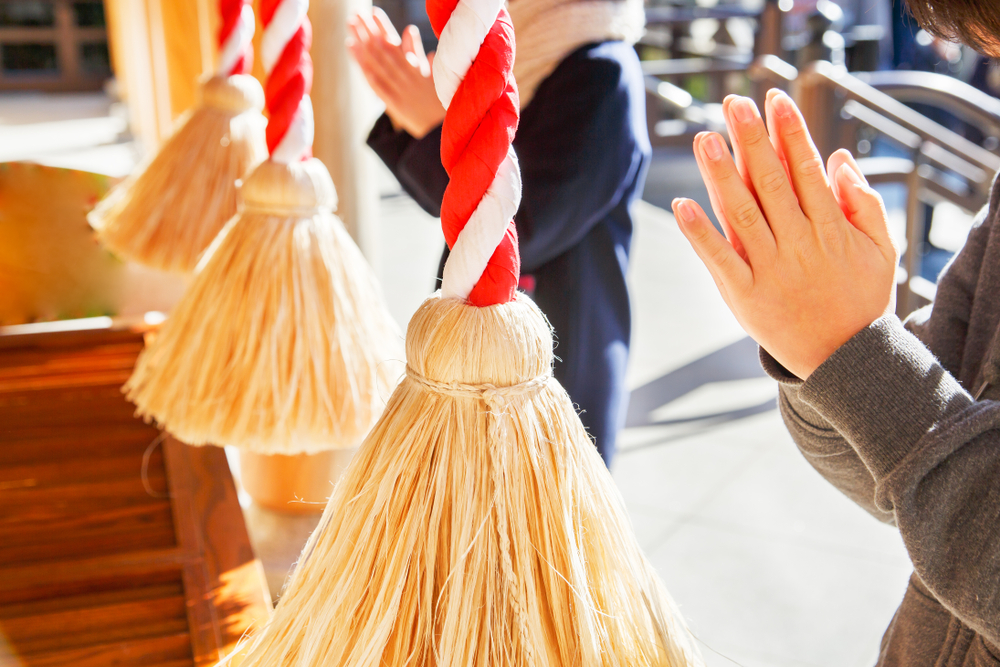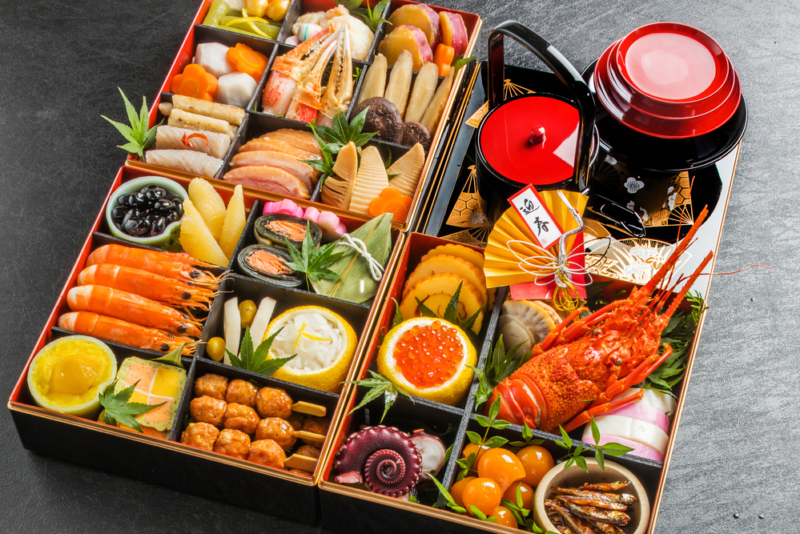Every country has a different way of ending the old year and ushering in the new. So, how does Japan do it? This article delves into this very topic, including New Year’s greetings, customs, and traditional Japanese foods. Why not try spending your New Year’s holiday the Japanese way?

When Do Japanese Celebrate the New Year?
In Japan, the New Year’s holiday typically lasts from December 29th till January 3rd. Many Japanese people will use this holiday time to visit relatives, so shinkansen (bullet trains) and airplanes are often packed.
Many Japanese companies have December 28th as the last work day of the year. On this day, they will often clean the office or have a small office party to close out the year (called “nokai” in Japanese). More extravagant celebrations, called “bonenkai” in Japanese, might also take place somewhere in December. Bonenkai is a merry event where company workers eat and drink together in a splendid end-of-the-year party. As a result, restaurants are often booked out in December, so if you want to eat out with a lot of people during this time, we recommend booking well in advance.
This Is How the Japanese End Their Year!
◆ New Year’s Greetings
良いお年を (Yoi o-toshi wo): This greeting is often used at the end of the year, around mid-December to December 30th. It is short for 良いお年をお迎えください (Yoi o-toshi wo o-mukae-kudasai), or in English, “Have a good (new) year!”
You can use the shortened form with coworkers and friends, but for clients and those positioned “above” you, please use the full sentence. Another warning is that if the person you’re greeting has recently (as far as one year back) had a loved one pass away, you should ditch the festive greeting and stick to 来年もよろしくお願いします (Rainen mo yoroshiku onegaishimasu), which is closer to the everyday Japanese greeting. (It translates literally to “Please treat me well next year.”)
From December 31st, you should use 来年もよろしくお願いします instead, as it is thought that your mind and surroundings are already fully prepared to welcome in the new year.

◆ Japanese Customs Right Before the New Year
・Send New Year’s Greeting Cards
Called 年賀状 (nengajo) in Japanese, these cards are sent to those close to you or that you have worked with that year in order to wish them a “Happy New Year” and ask that they continue to treat you well. In Japan, you can buy them at places like the post office and convenience store. If you want them to arrive on January 1st, make sure that you send your cards between December 15th to the 25th (excluding remote islands and other distant parts of Japan).
・Year-End Cleaning
Essentially, this is a deep clean of absolutely everything, including spots that you don’t usually clean, in order to get rid of grime and dust accumulated over the past year. If your workplace decides to do this, please lend them a hand. Also, garbage collection dates usually change at the end of the year, so make sure to complete your year-end clean by the final collection date.
・Put Up New Year’s Decorations
In Japan, once Christmas is over, you’ll start seeing New Year’s decorations everywhere. These decorations can be purchased from places like supermarkets and are believed to warmly welcome Toshigami, the god of the New Year.
Two decorations that you can easily set up at any rental apartment are a shimekazari (a decoration which shows that the place is ready to welcome Toshigami) and kagami mochi (a decoration which represents wishes for a good harvest and upcoming year). The shimekazari should be put up outside, such as on the apartment door, while the kagami mochi should be placed somewhere inside your home.
Although it differs between regions, typically New Year’s decorations should stay up from December 28th till January 7th. The day you actually eat the kagami mochi is called 鏡開き (kagami biraki) in Japanese, and it usually falls on January 11th for the Kanto region and January 15th for the Kansai region. As for how to dispose of the shimekazari, please purify it with salt, wrap it in paper, and throw it out in a separate bag as burnable garbage.

◆ How the Japanese Spend New Year’s Eve
・Preparing Osechi
“Osechi” is a type of traditional Japanese New Year’s food wherein 20-30 types of dishes are served in small portions. Every dish has a celebratory meaning to it, so let’s explore some of them below.

Shrimp: Since it curls up when you cook it, the Japanese believe it means that you’ll live long enough for your back to become curved.
Black beans: Black is believed to ward off evil. As for beans, they symbolize diligence and health.
Herring roe: Each piece has a lot of tiny roe, so it’s believed to bring luck in having children and passing on the bloodline.
・Ring the New Year’s Eve Bell
This is a Buddhist custom wherein a giant bell is rung 108 times from the night of New Year’s Eve till January 1st. Humans are believed to have 108 worldly desires, so the bell is rung 108 times to dispel them. There are temples where regular people can ring the bell, so do confirm with your local temple(s) beforehand if that’s something you want to do.
・Eat Toshikoshi Soba
“Toshikoshi soba” is basically soba eaten for lunch or dinner on December 31st. By eating it, you’re wishing to have a long life, much like the length of soba. Soba noodles are also easy to cut, meaning that you can properly cut away the stresses and bad luck of the previous year to usher in a brand new year.
・Watch Year-End Television
There are many shows that only broadcast from December 31st to January 1st, including at midnight. One of the most well-known shows is NHK’s Kohaku Uta Gassen, wherein singers are separated by gender (female = red, male = white) and compete with each other by singing and putting on spectacular shows.
This Is How the Japanese Welcome the New Year!

◆ New Year’s Greetings
明けましておめでとうございます (Akemashite omedetou-gozaimasu): In short, “Happy New Year!” It can be said to anyone, whether it’s your friends, coworkers, or even your boss. At the workplace, people often say “明けましておめでとうございます、今年もよろしくお願いいたします,” (Akemashite omedetou-gozaimasu! Kotoshi mo yoroshiku onegai-itashimasu.) which means “Happy New Year! Please treat me well this year, too.” How long you’re “allowed” to say this greeting really depends on the region, but generally people stop past January 7th.
◆ How the Japanese Spend New Year’s Day
・See the First Sunrise of the Year
It’s considered a sign of a good year to see the first sunrise of the new year in Japan. Some people will even go to areas where you can see it together with a gorgeous mountain or sea view.
・Eat Osechi or Ozoni
“Ozoni” is a soup dish with mochi in it. There are many regional differences with ozoni, from the ingredients used to the shape of the mochi and the seasonings for the soup. Why not try making your local region’s version of ozoni or ask your Japanese friends for their hometown recipes?
・Hatsumode
“Hatsumode” refers to the first temple visit of the year, but many people will actually pay their chosen temple a visit on the night of New Year’s Eve. Famous shrines and temples are always busy during hatsumode, but you can also go to your local shrine or temple to avoid the crowds. After paying your customary respects, you can check your fortune for the year or purchase o-mamori (protection amulets).
How Will You Spend Your New Year’s Holiday?
New Year’s customs and foods in Japan really differ by region, so why not ask your Japanese friends or partner how they celebrate the holiday in their hometowns? Furthermore, the ingredients and decorations are easily found at any Japanese supermarket, so give the Japanese way of spending the New Year’s a try!
If you want to give feedback on any of our articles, you have an idea that you’d really like to see come to life, or you just have a question on Japan, hit us up on our Facebook!
The information in this article is accurate at the time of publication.

